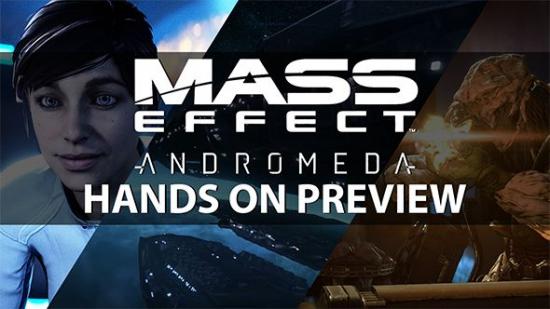One fantasy rests at the heart of Mass Effect: Andromeda: space, and the exploration of it. On a recent press day, I heard that BioWare felt the original trilogy narrowed in focus as the Reapers loomed larger, and that right from Andromeda’s initial concept work, the goal was to blow the galaxy wide open again.
But who will be your companion on this epic journey? Meet the candidates in our Mass Effect: Andromeda romance guide.
I was then treated to a generous two-mission demo, and my feeling from over four hours’ hands-on time with the game is that, in this at least, BioWare have succeeded. I’ll talk about the visuals and the gameplay, but it’s this game’s sheer size that most stays with me.
After driving the Nomad around the Badlands of Kadara, I know how much more there is to see on that planet alone, yet it’s just a fraction of what awaits you. I was told that “some” of the game’s “several” story planets will be as big as Dragon Age: Inquisition’s entire map, and that the squadmate with the least to say still has as many voice lines as Shepard did in all of Mass Effect 3.
So it’ll be big. But what will all that content consist of? Read on for a walkthrough of our demo and what I made of what I played. I’ll keep story spoilers to a minimum.
Character creation
I started right at the character creation screen, at the beginning of a new game. As was known previously, you’ll be able to choose your name, the appearance of yourself and of your twin, and your training. Once you start levelling up, you can choose skills freely from the usual tech, combat and biotics categories, but it’s your training that will decide your initial abilities.
There are six options: Security, Biotic, Technician, Leader, Scrapper and Operative. Most are roughly equivalent to the starting classes of previous games: operatives start with a tactical cloak and are basically infiltrators, while scrappers, who start with the biotic charge power and some points in combat fitness, are closest to vanguards. Leaders are trickier to place: they start with energy drain and a new skill called ‘team support’, which apparently gives access to special tech to help squad survivability.
Interestingly, you can choose Commander Shepard’s background in character creation. Less interestingly, your choice is limited to his or her gender. This suggests Shepard will be referenced, but not so extensively that the game needs to know about his or her achievements in detail.
Crafting
Things go wrong – I won’t say how – shortly after you arrive in Andromeda, and after a peremptory chat with Alec Ryder (your dad, emotionally distant, clearly a badass), I fly off to scout a nearby planet. Things go wrong again, and my shuttle crashes on the surface. Security specialist Liam Kosta lands nearby, and we set off to find the rest of our team.
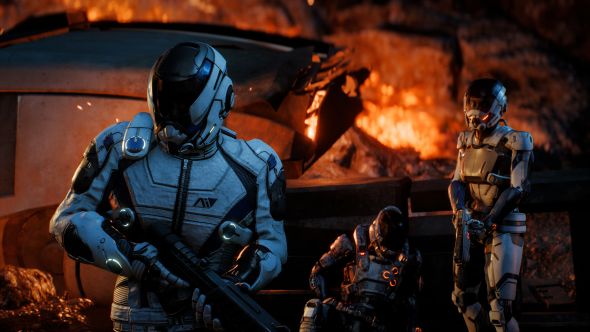
The scanner is the first gameplay feature to which we’re introduced. You can bring it up at the push of a button, and scan stuff in the environment to trigger musings from Ryder and colleagues. If you haven’t already scanned said stuff, you’ll get some points of research data (RD), which you can spend in the game’s crafting system.
Crafting starts with a blueprint. These can be obtained by looting the environment, or by spending RD to reverse-engineer recovered artefacts or materials. Once you have a blueprint, you’ll need to spend more RD to unlock it for manufacture (this represents you figuring out how the tech of a new galaxy actually works).
Once a blueprint has been studied, you’ll spend familiar resources gathered from the world, such as metallic elements and element zero, to craft your new gear. If you’re making a gun, you can add augmentations that permanently change its stats or behaviour. These are not mutually exclusive with mods, which you can swap whenever you change your loadout.
I got to tinker more in the second mission of my demo, which took place on the planet Kadara, with Ryder at level 16 and all six squadmates unlocked (some had clearly only just moved aboard the Tempest). There were dozens of different augs available on this save, from ones that did the obvious – like bonus damage against shields or armour – to more niche customisations, like bonus damage while hovering, or changing the fire mode to automatic or even beam. So naturally, I built a Black Widow (yes, it’s back) that fired lasers, and all was temporarily correct in the world.
If you’re wrong and your favourite gun wasn’t the Black Widow, it’s also clear there are lots of other classics returning. I spotted the regular Widow, the Revenant LMG, the M-96 Mattock and a number of N7 weapons including the Valiant, Crusader, Valkyrie and Eagle. There were too many to note individually, but my hunch is that most of your old favourites are back. An Asari sword and a Krogan hammer are among the exciting new additions – the hammer in particular feels brutally hefty.
Movement and combat
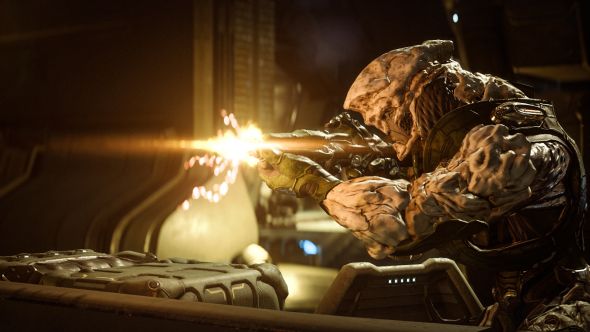
Back to the plot, and Liam and Ryder are using their jetpacks to scale a cliff. Many standard platforming features are here: you can sprint to increase your jump distance, you can mantle up ledges if you can get your fingers to them, you can tap the button for short jumps, or hold it for longer ones. Aiming in mid-air will cause you to hover – which is pretty cool – and another button will allow you to perform short-range dodges in any direction.
Jumping and dodging are on fairly short cooldowns, so I did feel quite nimble. There wasn’t much pressure on this early climb, but I wouldn’t be surprised if later levels featured some challenging platforming – the mechanics can support it.
Liam and I meet our first Kett, and it’s clear from the off that they don’t like us. There’s a tense scene in which you can decide how to initiate first contact, but one way or another, you’ll need to whip out your guns fairly soon.
The jetpack, dodging, and snapping into cover (rather than pressing a button) combine for the fastest combat in the series to date, while a mix of enemies present variable challenges even on the first mission: a pleasantly skilful stretch of headshotting Kett from cover is interrupted by alien hunting dogs who use their natural cloaks to flank me. I jump, evade backwards in mid-air, freeze my attacker with a cryo-beam while hovering, then finish it off with a melee attack. It’s a satisfying, reactive moment, of the kind that Mass Effect 3’s multiplayer or Armax Arsenal Arena often produced, but the jetpack is an escape route I didn’t have before.
It’s still important to concentrate, but now you have options if you make a mistake, whereas getting snuck up on by a Cerberus Phantom was basically a death sentence and a frustrating end to a fight that could’ve been going well up to that point. By the end of my time with the demo, I was sprinting, jumping and evading instinctively, both in combat and just for fun when exploring alien ruins.
Dialogue and chatting on the Tempest
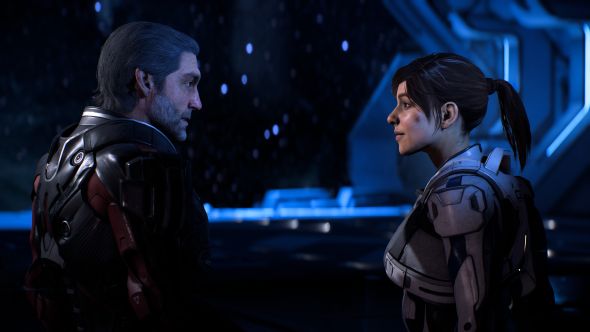
Before exploring Kadara on my second mission, I took a quick peek around the Tempest. As with the Normandy, this is where you’ll chat to squadmates and work on those romances. It feels much more alive and intimate than Shepard’s ship, partly due to its size; with two floors and narrow corridors, it’s even cosier than the original Normandy SR1. Squadmates can move around it independently, and can even be heard bickering with one another without Ryder’s involvement.
They mostly look beautiful, by the way; until you gaze into Drack’s crocodilic eyes and fawn over his scales and spines, it’s easy to forget that it’s been five years since you last saw a Krogan rendered in current technology. I can’t say that some of the odd animations observed in previous trailers have been entirely laid to rest – Peebee’s eyes moved erratically in one conversation, her lip syncing was off (more so than in most games, I mean), and Sara Ryder still looks a bit strange when she smiles. But these are very much the exceptions to the rule: most characters look great, and the game in general is stunning, from the rosy gas clouds of the galaxy map to the vibrant colours of Kadara’s surface.
The dialogue system has changed a lot since Mass Effect 3, but not much since Dragon Age: Inquisition. Icons in the centre of the dialogue wheel indicate the kind of response you’re giving: a fork is a simple branch in the conversation, while on other occasions you can react to a statement with one of up to four tones, seemingly grouped in opposing pairs: emotional or logical, and casual or professional. These tones will determine Ryder’s personality, and producer Fabrice Condominas confirmed that some conversation options will be locked according to this, much like the Paragon and Renegade systems in the original trilogy. A hot-headed, emotional Ryder will be able to interact with others in ways that a cool, collected Ryder won’t, and vice versa.
Ryder’s training is also referenced in conversation. While playing the first mission as an operative, and reporting to Alec that I’d found some alien ruins, he says “Huh, so you actually did some scouting”, in what I sensed was a rare drip of praise. Ryder can answer “Well, it is what I trained for”, with a hint of resentment. (There’s every chance this is going to turn out to be a pretty screwed up family.)
The Nomad, and exploring and settling planets
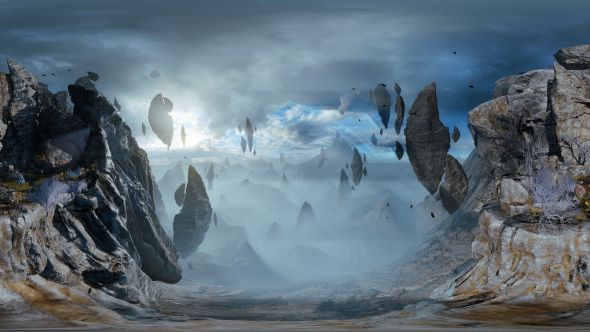
BioWare have said Andromeda is not an open world game, and this is true. Rather, each planet is an open world, and accessing them is gated by plot events, much like the original trilogy. Roving across the surface of Kadara in the Nomad feels similar to wandering in Velen in The Witcher III, or in a new area in Dragon Age: Inquisition. It’s worth remembering that Mass Effect has threatened to do this sort of thing before: exploring planets in Andromeda is basically just a more detailed version of exploring Aite in the Hammerhead in Mass Effect 2’s Overlord DLC, or a much more detailed version of a Mako patrol in the original Mass Effect.
The Nomad has two driving modes, one for racing across open ground, and one for grinding up hills and rough terrain (it took me a minute to realise this, which made hill-climbs no fun at all at first). It can’t jump as high as the Mako or the Hammerhead, and generally feels much heftier than either (the Need for Speed team helped out on its handling). There is GTA-esque squadmate banter as you’re driving around – Jaal, as an Andromeda native, doesn’t understand Milky Way idioms, so, much like Drax from Guardians of the Galaxy, he takes everything literally.
You’ll pick up side quests and get distracted much as you would in any other open world game: I drive through a filtration plant with a bunch of massacred Angara, and get given a quest to find out what happened. I meet a nice Salarian in a wind farm, and a nasty Turian running a very suspicious hotel. SAM – your team’s AI assistant – picks up a distress call, which leads to a pair of stoned human outlaws whose “emergency” was that their “medicinal plants” – which they sell for a living – are dying. A funny chat ensues. These are the encounters that most uphold BioWare’s ambition for quests to feel meaningful; they’re very like The Witcher III (and very unlike your average Assassin’s Creed) in that you’ll never really know what to expect until the quest finishes.
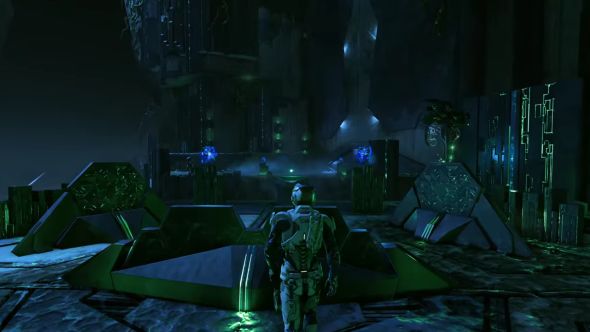
That’s not to say some quests don’t have a bit of formula in common. While driving around, I trigger the ‘settling Kadara’ quest, in which I have to solve various problems to render the planet habitable. First up is taking care of its toxic groundwater, then settling a dispute between two local warring factions (both of which you can, apparently, join, but Condominas politely declined to provide more details). Finally, I have to stabilise the environment by resetting the local Remnant Vault – more on that in a sec.
All these jobs increase Kadara’s ‘viability’, and my goal is to reach 40%, at which point I can build an outpost at a designated site. Some settlements will be part of the game’s critical path – that is, you’ll need to finish some settling quests to advance the plot – while the incentive to complete optional ones is, essentially, more resources: you can designate a specialism for each outpost, so mining outposts might give a steady trickle of crafting materials, while research outposts might give research data. Condominas says the quest to raise viability depends on each planet’s problems, so like The Witcher III’s monster hunts, the goal and the reward are approximately known, but the particulars will vary.
How much they do so with respect to Remnant quests is less clear. There were three Remnant monoliths on Kadara, of which I only had time to solve one – presumably, the vault opens after you crack all of them. My challenge was to clamber over the many-armed monolith, using the scanner to find and capture images of Remnant glyphs. A console in the centre of the monolith contains a small sudoku puzzle: a 4×4 grid is divided into four 2×2 squares, and I had to add copies of the four glyphs I’d found to the grid such that no glyph was repeated in the same column, row, or square. I can’t say whether the puzzles differ between monoliths, but I hope so; doing this three times on several planets each would be a bit of a chore.
Getting away from the apocalypse
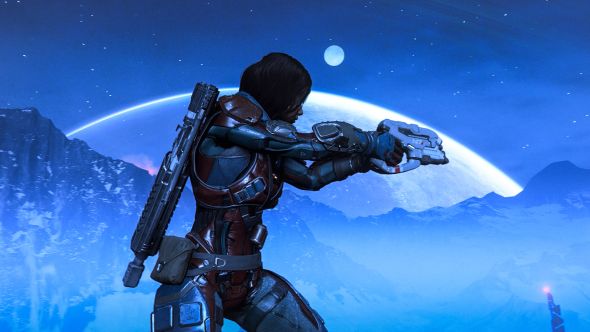
Any preview must have the caveat that it’s only a slice of the final game, but impressing that seems even more important given the likely size of Andromeda. It’s reasonable to wonder whether quality can remain high across the board when there’s so much quantity, but with five years of development, and on current evidence, there’s every reason to be optimistic.
Its size is exciting, but also daunting. I’m playing through the original games right now, and remembering how the downtime on the Normandy can kill the pace when there’s such pressure to check squadmates for new dialogue after every mission. It seems that pressure will be more acute than ever here, but that’s the particular neurosis of a completionist, and it definitely seems churlish to complain about the size of this game when it’s being offered for the same price as any other triple-A title, and when it all looks so good.
It’s honestly pretty promising. I agree with BioWare’s assessment of the original trilogy: the Reapers loomed ever larger over its rich setting, gradually squeezing what could have been the best swashbuckling space opera in gaming into a doom-laden story about the apocalypse. The whole tone of Mass Effect 3 is positively miserable, and in that context, the moments of levity come tainted with guilt. As lovely as all the fan service in the Citadel DLC is, really, what am I doing throwing a party for my friends when the Reapers are massacring millions on Earth at this very second?
It’s clear that the stakes will be plenty high in Andromeda, but BioWare aren’t going overboard and losing the potential of the setting. It’s bright, it’s colourful, it’s diverse, with plenty to see and do. A final verdict is pending, but I’m definitely not cancelling my pre-order.
